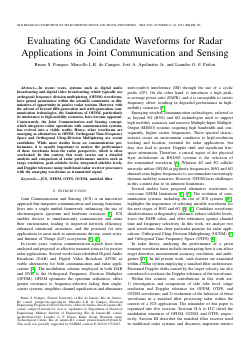
Evaluating 6G Candidate Waveforms for Radar Applications in Joint Communication and Sensing
Bruno Pompeo, Marcello L. R. de Campos, José Antonio Apolinário Jr., Leandro Guimarães Figueroa Pralon
DOI: 10.14209/sbrt.2024.1571034210
Evento: XLII Simpósio Brasileiro de Telecomunicações e Processamento de Sinais (SBrT2024)
Keywords: 6G waveforms JCS OFDM OTFS
Abstract
In recent years, systems such as digital audio broadcasting and digital video broadcasting, which typically use orthogonal frequency division multiplexing (OFDM) waveforms, have gained prominence within the scientific community as illuminators of opportunity in passive radar systems. However, with the advent of beyond fifth-generation and sixth-generation communication technologies, the limitations of OFDM, particularly its intolerance to high-mobility scenarios, have become apparent. Concurrently, the Joint Communication and Sensing concept, which integrates radar operations with communication systems, has evolved into a viable reality. Hence, other waveforms are emerging as alternatives to OFDM. Orthogonal Time-Frequency Space and Orthogonal Chirp-Division Multiplexing are recent candidates. While most studies focus on communication performance, it is equally important to analyze the performance of these waveforms from the radar perspective, which is often overlooked. In this context, this work carries out a detailed analysis and comparison of radar performance metrics such as range resolution, peak sidelobe levels, integrated sidelobe levels, and Doppler tolerance using traditional radar receiver processors with these emerging waveforms as transmitted signal.Download